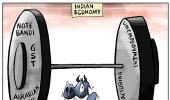Neither the foreign exchange, nor the gold, and certainly not the revaluation reserve should be available for spending by anyone. he revaluation account is simply not money. It is simply an accounting entry, says Rashmin C Sanghvi.

Media claims that the Reserve Bank of India (RBI) has a reserve of Rs 9.6 trillion.
The government wants a portion of this money to be transferred to it for its expenses. Let us examine the accounting and economic details.
As per the balance sheet of the RBI, the total share capital and reserves are Rs 6,726 crore. There is no other reserve on the balance sheet. All the amounts actually represent liabilities payable, or provisions made by the RBI.
The RBI’s contingency fund of Rs 232,108 crore is a provision. There are assets of equivalent value with the RBI. Hence it is called the “contingency fund”.
This fund is invested in government securities. If the government wants the RBI to use this fund and declare dividend, the government has to repay the loans.
Out of the loan repayment, the RBI can declare a dividend. Does it make much sense?
Now come to the currency and gold revaluation account (Rs 691,641 crore). Separate details for currency revaluation and gold revaluation are not available. To clarify the principles involved, let us assume some simplified figures.
Say Mr. ABC has an office that he purchased in the year 2000 at a cost of Rs 1 crore. Today, this office is worth Rs 3 crore.
Mr ABC prepares a balance sheet at current market value. So he shows asset at Rs 3 crore and makes a revaluation reserve of Rs 2 crore.
In the books, his capital has gone up by Rs 2 crore. Can he spend this money (Rs 2 crore)?
Asset revaluation does not generate any money. He can’t use the money without selling the office.
Similarly, the RBI has foreign exchange reserves of $400 billion. It cannot generate cash in rupee terms to pay dividend to the government unless it sells the foreign exchange reserves.
Let us assume the RBI’s foreign exchange reserves of $400 billion have been acquired at an average cost of Rs 50 per dollar.
The cost of foreign exchange reserves is Rs 200,000 crore (400 X 50). Now the rupee has depreciated to Rs 70 per dollar. This means all imports including crude oil cost us more.
Several costs, including transport cost, go up. Hence our exports become less competitive in the international market. The economy suffers.
However, the market value of foreign exchange reserve is now Rs 280,000 crore (400 X 70). There will be a currency revaluation account of Rs 80,000 crore.
What is the meaning of foreign exchange reserve? It is an illusory term. When we say there is a reserve, people feel that it is generated out of profits made.
In reality, RBI has not created this reserve out of profits earned. When an Indian businessman exports goods or services, he earns foreign exchange.
Under the Foreign Exchange Management Act (FEMA), every Indian resident is compelled to sell the foreign exchange earned by him to his bank.
The bank surrenders the foreign exchange to the RBI. This, inter alia, is how the RBI creates its foreign exchange reserve.
For every dollar of foreign exchange taken by the RBI, an equivalent amount in rupee terms, is paid to the exporter.
Every rupee issued by the RBI is a liability. If the RBI has $400 billion on the asset side of its balance sheet, an equivalent amount is its liability as rupee notes issued to exporters.
If the government spends this money, it would be, to use a popular phrase, “printing notes out of thin air”.
Now consider the gold revaluation reserve. The RBI has more than 500 tonnes of gold as reserve.
Let us assume, it was acquired at an average price of Rs 20,000 per 10 gm. Now because of rupee depreciation, gold price has gone up to Rs 30,000 per 10 gm.
On revaluation of the gold at market price, there will be a gold revaluation account of Rs 50,000 crore (Rs 10,000 appreciation per 10 gm X 500 tonnes.) It is not a reserve.
The RBI considers it necessary to maintain this gold and foreign exchange reserve.
This will be used in case of a future crisis. We should not forget the massive speculative attacks on world currencies - including on the Indian rupee in the years 1992, 1997 and 2013.
My submission is that neither the foreign exchange, nor the gold and certainly not the revaluation reserve, should be available for spending by anyone.
The revaluation account is simply not money. It is simply an accounting entry.
Rashmin C Sanghvi is chartered accountant and partner, Rashmin Sanghvi & Associates
Photograph: Shailesh Andrade/Reuters











